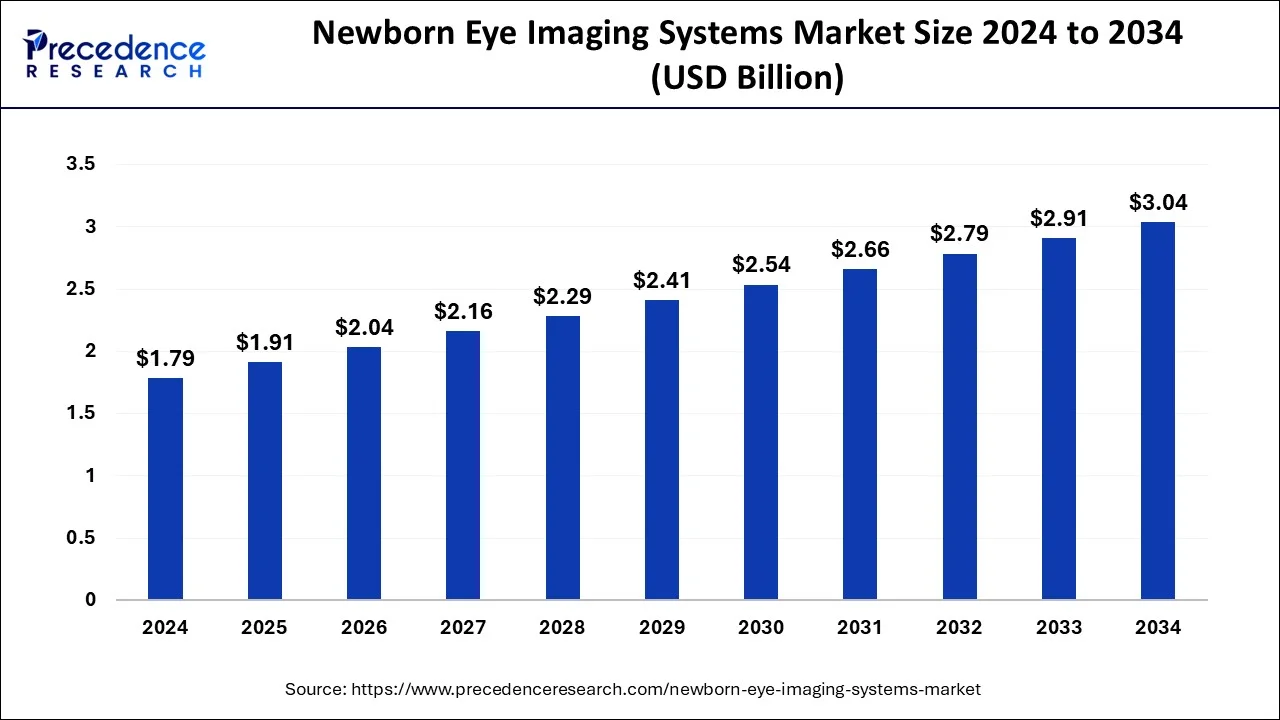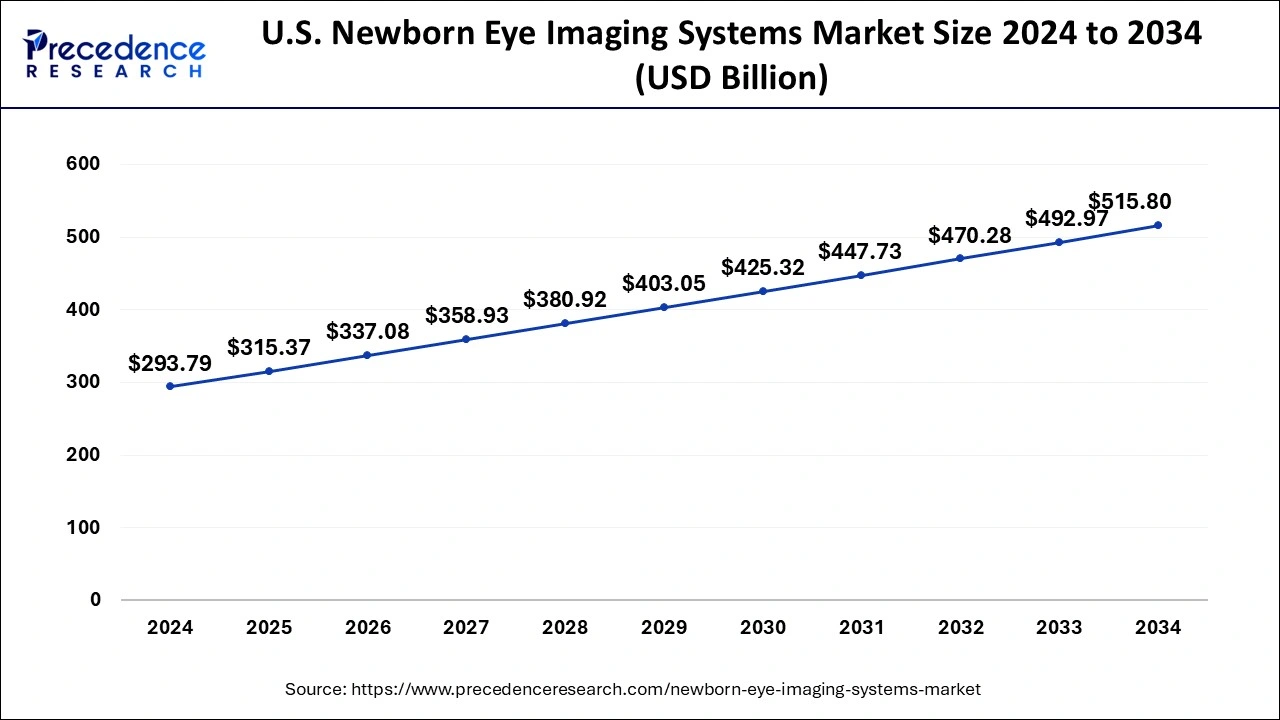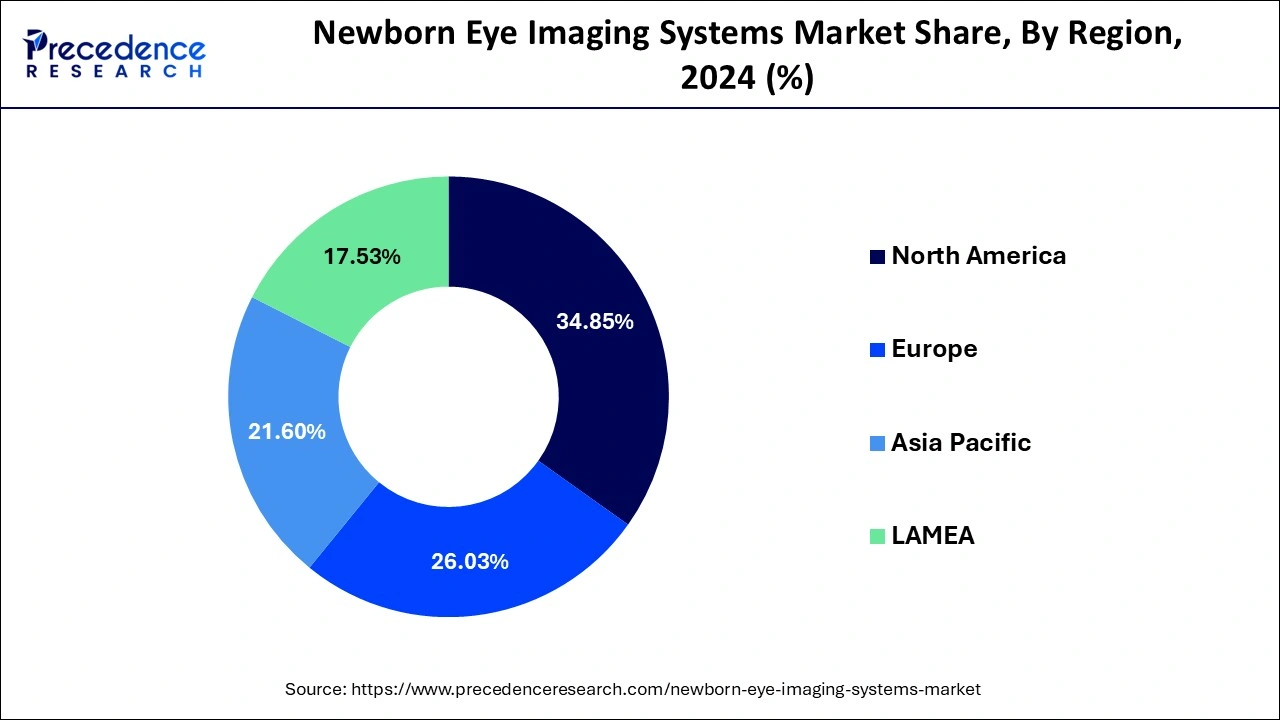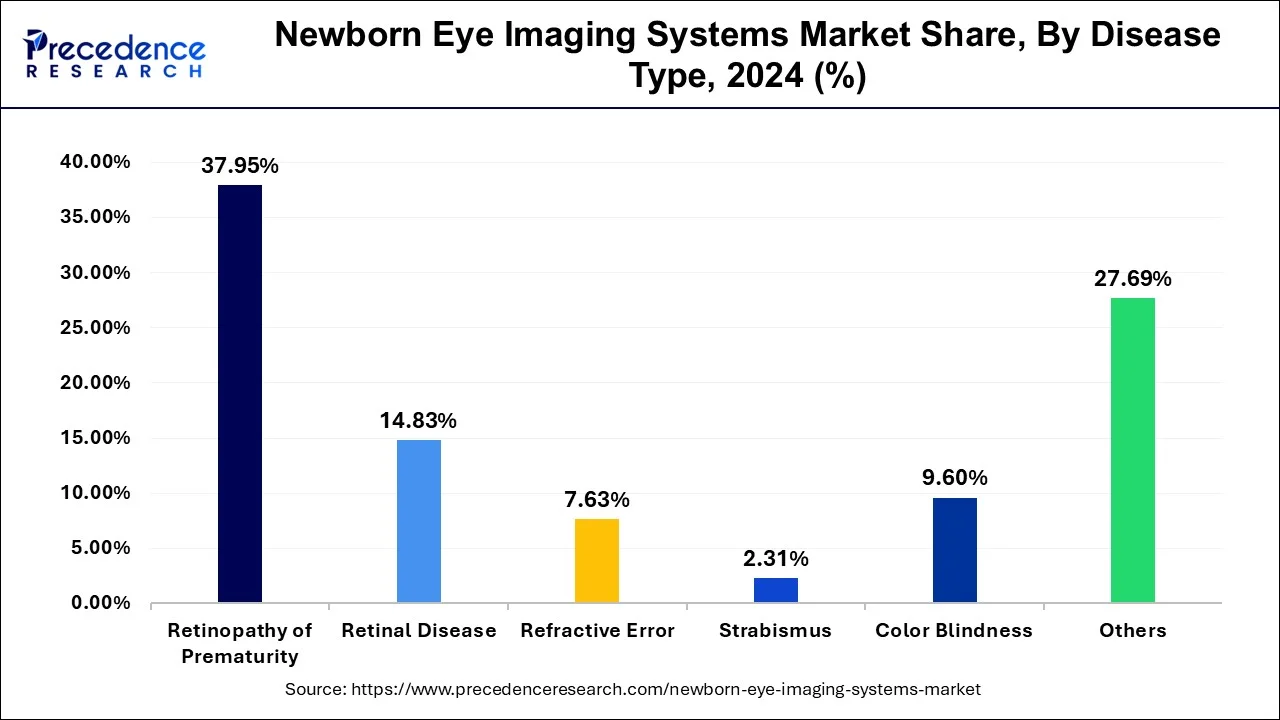Newborn Eye Imaging Systems Market Size and Forecast 2025 to 2034
The global newborn eye imaging systems market size was estimated at USD 1.79 billion in 2024 and is predicted to increase from USD 1.91 billion in 2025 to approximately USD 3.04 billion by 2034, expanding at a CAGR of 5.30% from 2025 to 2034.

Newborn Eye Imaging Systems Market Key Takeaways
- North America generated more than 34.85% of revenue share in 2024.
- Europe gained a notable share of around 26.03% in 2024 and will grow at the quickest rate from 2025 to 2034.
- By disease type, the Retinopathy of Prematurity (ROP) segment accounted for more than 37.95% of revenue share in 2024.
- By disease type, the retinal disease segment is progressing at a CAGR of 5.5% from 2025 to 2034.
- By device type, the basic device segment captured around 55.38% of revenue share in 2024.
- By device type, the wireless device segment is growing at a CAGR of 5.9% from 2025 to 2034.
- By end user, the hospital segment generated around 38.59% of revenue share in 2024.
- By end user, the ophthalmology and diagnosis center segment is growing at a CAGR of 5.7% from 2025 to 2034.
U.S. Newborn Eye Imaging Systems Market Size and Growth 2025 to 2034
The U.S. newborn eye imaging systems market size was estimated at USD 293.79 million in 2024 and is predicted to be worth around USD 515.80 million by 2033, at a CAGR of 5.60% from 2025 to 2034.

North America accounted for the largest revenue share of over 34.85% in 2024. The global dominance of North America can be attributed to the rising prevalence of eye diseases such as diabetic retinopathy and glaucoma. An increasing number of newborns are suffering from eye disorders and looking for minimally invasive treatments. According to the Boston Children's Hospital, in 2022, around 250 children in the United States were diagnosed with retinoblastoma, a type of cancer.
It primarily affects children under the age of five, with the highest incidence occurring between the infant stages and the age of two. Retinoblastoma can develop in either eye but is found in both eyes in approximately 25 to 30% of cases. Furthermore, the increasing adoption of AI is propelling this region's growth. In the United States, AI has effectively diagnosed a blindness-causing disease in premature newborns.

Europe gained a significant share of around 25.84% in 2023 and will grow at a CAGR of 6.32% in the forecast period. Germany had the largest share, followed by the United Kingdom and France. The rising prevalence of ROP is driving the expansion of this region. ROP is a Vaso proliferative retinal condition that primarily affects premature infants. ROP has become the leading cause of preventable childhood blindness in this region, owing to the increased survival of premature newborns. According to the Europe PMC Funders' Group, ROP is a blinding disease that affects premature children.
North America held the largest share of the newborn eye imaging systems market in 2024.
- In January 2024, to develop sustainable infrastructure to save the vision of premature infants in low- and middle-income countries, Siloam Vision and Orbis International announced a strategic collaboration.
Partners collaborate on the integration of AI-supported ROP telemedicine globally.
Europe is projected to host the fastest-growing market in the coming years.
- In September 2022, Sunderland Royal Hospital became one of the first in Europe to use the technology thanks to a £70000 fundraising campaign by the Red Sky Foundation, which was launched by Sergio and Emma Petrucci.
What is the Role of AI in the Newborn Eye Imaging Systems Market?
Rapid advancements of AI technology with an enhanced ability to perform well even with smaller datasets, and the recent regulatory approvals of autonomous AI solutions in the ophthalmology space, autonomous newborn retina screening with AI may become highly available soon. AI helps to overcome the risks of retinal image analysis for ROP detection arising from variations in patient phenotypes, inconsistencies in retina image quality, and changes in expert interpretations, potentially leading to reduced burden on healthcare professionals and enhanced diagnostic accuracy.
AI applications in ophthalmology span a broad spectrum of diseases and interventions. AI algorithms have demonstrated high accuracy in detecting diabetic retinopathy, age-related macular degeneration, and retinopathy of prematurity from retinal images. AI applications tested in neonatology include tools for monitoring vital signs, disease prediction, and risk assessment
MarketOverview
Most vision problems that cause adolescent blindness can be treated if detected early through comprehensive newborn screening. Some of the common eye disorders are retinopathy of prematurity (ROP), ocular development, strabismus, visual acuity, color vision, visual functions, and visual fields. These disorders require an eye imaging system for detection and treatment. Over the years, there have been significant advancements in both design and technology.
Such advances have applications in most pediatric retinal illnesses, whereas new device designs are frequently limited to adult use. The rising number of pediatric retinal operations, the increasing prevalence of eye disorders of different etiologies, and technological advancements in product development are all expected to boost product demand and thus drive the growth of the newborn eye imaging systems market.
Market Trends
- Rise in public health awareness programs by the government
- Rising demand for non-invasive imaging
- Technological advancements
- Rising cases of ophthalmic disorders
Market Scope
| Report Coverage | Details |
| Growth Rate from 2025 to 2034 | CAGR of 5.30% |
| Market Size in 2024 | USD 1.79 Billion |
| Market Size in 2025 | USD 1.91 Billion |
| Market Size by 2034 | USD 3.04 Billion |
| Largest Market | North America |
| Base Year | 2024 |
| Forecast Period | 2025 to 2034 |
| Segments Covered | Disease Type, Device Type, End User, and Region |
| Regions Covered | North America, Europe, Asia-Pacific, Latin America and Middle East & Africa |
Market Dynamics
Drivers
Increasing expenditure on healthcare
Growing healthcare expenditure in various economies significantly impacts the constant growth of the newborn eye imaging systems market. The COVID-19 outbreak highlighted the importance of the healthcare industry and its links to other economic sectors.
According to National Health Expenditure data, hospital expenditures increased 6.4% to $1,270.1 billion in 2020, up from 6.3% in 2019. Furthermore, rising awareness and spending on neonatal care and screening procedures to prevent a wide range of disorders are driving market growth. For instance, on March 30, 2022, the World Health Organization issued its first global guidelines to support women and newborns in the postnatal period.
Restraints
Lack of skilled and experienced staff
There is a need for a more clinical and skilled workforce in newborn eye imaging systems and trained ophthalmic photographers. Thus, new technologies must be designed, and healthcare providers with minimal training can use that. Most imaging requires large tabletop systems, but there is also a demand for portable imaging devices such as hand-held OCT and intra-operative OCT.
Furthermore, as reimbursements for imaging have decreased, the amount of time retina professionals spend on each patient has reduced. Many doctors now spend 5 to 10 minutes per patient gathering patient history, examining, analyzing, interpreting imaging, responding to patient questions, informing, and treating the patient.
Opportunities
Advances in newborn eye imaging systems technology
Emerging imaging technologies, such as artificial intelligence (AI) and deep learning, have the potential to screen large populations, including infants, for retinal disorders in a resource-constrained environment. Clinical studies have demonstrated AI's effectiveness in detecting the existence of various vision-threatening conditions such as age-related macular degeneration, diabetic retinopathy, retinopathy of prematurity, and neurological disorders such as Alzheimer's.
Furthermore, smartphones are used primarily as fundus cameras due to specialized adaptors. It is the least expensive method of photographing a retina. In numerous studies, the smartphone-based retinal camera has produced results comparable to those of a desktop fundus camera. Most smartphone-based retinal cameras have a field of vision of 30 to 45 degrees. For instance, the Volk iNview is an ophthalmic camera that uses an Apple iPhone or iPod to capture wide-angle digital color images of the retina (fundus). Volk iNview is a hybrid product that combines a mobile app (Apple App Store) and an indirect ophthalmoscopic lens attachment.
Disease Type Insights
The retinopathy of prematurity (RoP) segment held a dominant presence in the market in 2024.
- In July 2025, $67k of neonatal equipment to prevent blindness in preterm babies in Ghana was received by KATH from Africa Eye Imaging Center in collaboration with Zero Blind Babies.
The retinal disease segment is expected to grow at the fastest rate in the market during the forecast period of 2025 to 2034.

For instance, in 2022, Mary's Medical Center in Grand Junction launched Colorado's first telemedicine service for infants with ROP. These programs have demonstrated digital retinal imaging's dependability, accuracy, and economic viability. Digital retinal images are also used in tele-educational programs to increase the number of ROP-trained medical professionals.
The retinal disease segment is expected to grow at a CAGR of 5.5% over the forecast period. The retina is a layer of tissue at the back of the eye that detects light and transmits images to the brain, and retinal diseases impact this vital tissue. Some retinal conditions can be treated early, while others can be slowed or controlled to protect vision. Typical retinal issues include retinal tears, retinal detachment, retinopathy, epiretinal membranes (ERMs), macular holes, and macular degeneration. The growing prevalence of these issues will drive segment growth.
Device Type Insights
The basic device segment accounted for a considerable share of the market in 2024.
- In June 2024, to launch new telemedicine and AI-enabled portable equipment for smooth and quick eye checkups and detecting eye diseases in real-time, C3-Med-Tech, involved in the development and manufacturing of ophthalmic screening devices, announced that it has secured an undisclosed amount from Industrial Metal Powders.
The wireless device segment is projected to experience the highest growth rate in the market between 2025 and 2034.
- In September 2023, to use the company's cloud-based telemedicine platform to expand access to eye care and prevent blindness in premature infants living in hard-to-reach communities, eye care nonprofit Orbis International launched a new strategic collaboration with Siloam Vision.
Newborn Eye Imaging Systems Market Revenue, By Device Type, 2022-2024 (USD Million)
| By Device Type | 2022 | 2023 | 2024 |
| Basic Device | 859.62 | 924.66 | 988.99 |
| Wireless Device | 676.35 | 736.24 | 796.85 |
End-User Insights
The hospital segment led the market.
- In June 2024, laser vision correction technology, making it the first provider of this technology for patients across North India, excluding Delhi NCR, was introduced by Bansal Eye Hospital in Ambala. This technology uses the ELITA laser system by Johnson & Johnson to treat myopia and astigmatism.
Bansal Eye Hospital unveils laser vision correction technology - Healthcare Radius.
The ophthalmology & diagnosis center segment is set to experience the fastest rate of market growth from 2025 to 2034.
- In May 2025, a new relocatable ophthalmic diagnostic and treatment center in Hereford, England, that will work to improve access to high-quality eye care for local patients was launched by SpaMedica.
SpaMedica opens a relocatable diagnostic and treatment center in Hereford, England.
Newborn Eye Imaging Systems Market Revenue, By End-User, 2022-2024 (USD Million)
| By End User | 2022 | 2023 | 2024 |
| Hospital | 590.71 | 639.88 | 689.23 |
| Ophthalmology Diagnosis Centers | 409.48 | 444.48 | 479.73 |
| Ambulatory Surgical Centers | 293.16 | 319.76 | 346.83 |
| Others | 242.62 | 256.79 | 270.05 |
Newborn Eye Imaging Systems Market Companies
- Visunex Medical Systems
- Eye Photo Systems
- MergeHealthcare
- D-EYE
- Imagine Eyes
- Natus Medical
- Servicom Medical
Recent Developments
- In June 2024, to launch new medicine and AI-based portable equipment for smooth and quick eye checkups and detecting eye diseases in real time, C3 Med-Tech, involved in the development and manufacturing of ophthalmic screening devices, announced that it has secured an undisclosed amount from Industrial Metal Powders.
- In May 2025, a new device, ‘Pristine', innovating AI-based eye diagnostics, Remidio. This aims to address the full spectrum of eye care needs, from last-mile screening to advanced clinical diagnostics.
Segments Covered in the Report
By Disease Type
- ROP
- Retinal Disease
- Strabismus
- Refractive Error
- Color Blindness
- Others
By Device Type
- Basic Device
- Wireless Device
By End-User
- Hospitals
- Ophthalmology Diagnosis Centers
- Ambulatory Surgical Centers
- Others
ByGeography
- North America
- Europe
- Asia-Pacific
- Latin America
- The Middle East and Africa
For inquiries regarding discounts, bulk purchases, or customization requests, please contact us at sales@precedenceresearch.com
Frequently Asked Questions
Ask For Sample
No cookie-cutter, only authentic analysis – take the 1st step to become a Precedence Research client
 sales@precedenceresearch.com
sales@precedenceresearch.com
 +1 804-441-9344
+1 804-441-9344